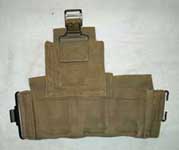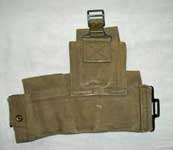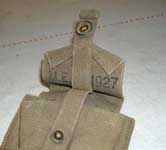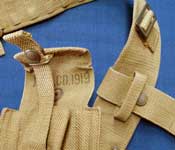Pattern 1925 Khaki Web Equipment - Equipment Carriers
As has been noted, W.E. Patt. '25 was designated as Web Equipment, Pattern 1919 in Canada. To distinguish it from the OTHER Patt. '19, we've tried to consistently refer to it as Pattern 1925. However, the title and text of Canadian Militia Order 500 are quoted as written, so you may well find both designations in the same paragraph.
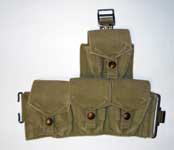
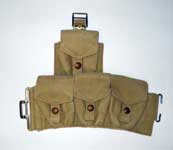 The Pattern 1925 Cartridge carriers were introduced into Canada with the Web Equipment, Pattern 1919, under Militia Order 500, dated 28th September 1928. The Carriers are mirror images of each other, and connect to the Strap, back adjustment. Each Carrier has four pockets, and each pocket holds 15 rounds of .303-inch ammunition in three 5 round chargers. This provides a total ammunition load of 120 rounds. The cartridge pockets are integrally woven, rather than folded and sewn like the Canadian blue-grey ones. If you compare these Carriers with the Canadian made examples in the Patt. '25 Blue-Grey Equipment Carrier Section, the differences can be easily seen.
The Pattern 1925 Cartridge carriers were introduced into Canada with the Web Equipment, Pattern 1919, under Militia Order 500, dated 28th September 1928. The Carriers are mirror images of each other, and connect to the Strap, back adjustment. Each Carrier has four pockets, and each pocket holds 15 rounds of .303-inch ammunition in three 5 round chargers. This provides a total ammunition load of 120 rounds. The cartridge pockets are integrally woven, rather than folded and sewn like the Canadian blue-grey ones. If you compare these Carriers with the Canadian made examples in the Patt. '25 Blue-Grey Equipment Carrier Section, the differences can be easily seen.
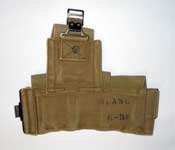
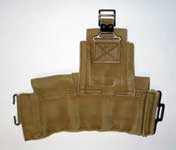 Rear views of the same pair of Carriers. This particular pair, maker marked "M.E. Co." and dated 1928, are Canadian C-broad arrow marked, and the right Carrier is also marked "RCASC / 6-38". This pair were part of the Canadian W.E. Pattern 1919 issue approved under Canadian Militia Order 500. Oddly, the spigot portion of the press fastener is missing from the left Carrier. Compare this left Carrier with the one shown below to see what is missing. Whilst this is the only pair of Canadian Patt. '19 Cartridge Carriers KW have seen, we think it is most likely that this is simply an omission in manufacture, rather than a feature of the Canadian '19 issue that differs from the "standard" Pattern 1925 design. We would certainly welcome information from any reader who has another Canadian marked pair, and who can confirm or deny this supposition.
Rear views of the same pair of Carriers. This particular pair, maker marked "M.E. Co." and dated 1928, are Canadian C-broad arrow marked, and the right Carrier is also marked "RCASC / 6-38". This pair were part of the Canadian W.E. Pattern 1919 issue approved under Canadian Militia Order 500. Oddly, the spigot portion of the press fastener is missing from the left Carrier. Compare this left Carrier with the one shown below to see what is missing. Whilst this is the only pair of Canadian Patt. '19 Cartridge Carriers KW have seen, we think it is most likely that this is simply an omission in manufacture, rather than a feature of the Canadian '19 issue that differs from the "standard" Pattern 1925 design. We would certainly welcome information from any reader who has another Canadian marked pair, and who can confirm or deny this supposition.

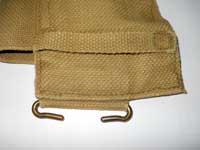 Details of the Carriers shown above. The photo near left is a rear detail of the left Carrier, showing that the webbing has not been disturbed, which confirms that the press fastener spigot was never installed. From the Karkee Web Collection.
Details of the Carriers shown above. The photo near left is a rear detail of the left Carrier, showing that the webbing has not been disturbed, which confirms that the press fastener spigot was never installed. From the Karkee Web Collection.
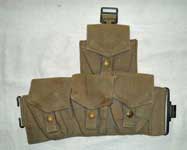
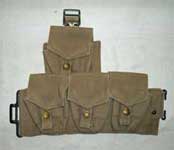 This pair of Cartridge carriers is maker marked "M.E. Co." and dated 1927. In this pair, the left-hand Carrier does have the spigot half of this press fastener, which mates with the crown fastener on the Frog. From the Karkee Web Collection.
This pair of Cartridge carriers is maker marked "M.E. Co." and dated 1927. In this pair, the left-hand Carrier does have the spigot half of this press fastener, which mates with the crown fastener on the Frog. From the Karkee Web Collection.
The rear side of the same pair of Carriers.
The picture far left, a detail of the set shown just above, shows the retaining strap sewn in under the cartridge pocket flap. This was to prevent the chargers from falling out if the flap came unsnapped. The strap is "pinched" by stitching, at the fold. It differs from the similar detail on the "proper" British Patt. '19 Cartridge carriers. In that design, the strap was of the "slider strap" principle, first used on the left-hand Mark II Cartridge Carriers of Patt. '08 W.E. An example of the British Pattern 1919 Cartridge carrier, from the Brian Burns Collection, is shown near left. That photo © Brian J. Burns 2009.

 The Pattern 1925 Bayonet frog was introduced into Canada with the Web Equipment, Pattern 1919, under Militia Order 500, dated 28th September 1928. It is identical to the W.E. Patt. '19 Infantry Equipment Bayonet Frog and has the crown half of the fastener to attach it to either the left cartridge carrier or the back adjustment strap. It is designed to carry the Pattern 1907 bayonet in scabbard. An almost identical Frog, in khaki and without the fastener, was used as the first variant of Frog issued with W.E. Patt. '37. This example is maker marked "M.E. Co." and dated 1927. From the Karkee Web Collection.
The Pattern 1925 Bayonet frog was introduced into Canada with the Web Equipment, Pattern 1919, under Militia Order 500, dated 28th September 1928. It is identical to the W.E. Patt. '19 Infantry Equipment Bayonet Frog and has the crown half of the fastener to attach it to either the left cartridge carrier or the back adjustment strap. It is designed to carry the Pattern 1907 bayonet in scabbard. An almost identical Frog, in khaki and without the fastener, was used as the first variant of Frog issued with W.E. Patt. '37. This example is maker marked "M.E. Co." and dated 1927. From the Karkee Web Collection.
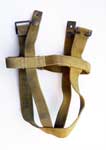
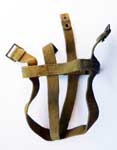 Militia Order 500, dated 28th September 1928 introduced Web Equipment, Patt. ‘19 for “…Infantry Units of the Permanent Force…”. Unfortunately, the Canadian authorities did not choose the correct nomenclature, naming it for its “back-adjustment” feature, which was what Naval Patt. ’19 used. However, the inclusion of a two-part Rucksack immediately shows that it was Pattern 1925 W.E., as had been adopted by the R.A.F. and R.C.A.F., but in blue-grey.
Militia Order 500, dated 28th September 1928 introduced Web Equipment, Patt. ‘19 for “…Infantry Units of the Permanent Force…”. Unfortunately, the Canadian authorities did not choose the correct nomenclature, naming it for its “back-adjustment” feature, which was what Naval Patt. ’19 used. However, the inclusion of a two-part Rucksack immediately shows that it was Pattern 1925 W.E., as had been adopted by the R.A.F. and R.C.A.F., but in blue-grey.
The R.A.F. were still using drab Patt. ’08 and, with it, a Bottle, water, enamelled, Mark VI. This was a blue-enamelled bottle, in a khaki felt cover. To enable the bottle to be used with either drab ’08 W.E., or blue-grey ’25 W.E., the drab felt Cover needed to be concealed. The R.A.F. therefore adopted a sleeve type Carrier, which the Army would later call “bucket type”. The R.A.F. Carrier was effectively a special order, as Mills’ design was for a framework Carrier. Normally, sleeve Carriers were used in Mills’ designs for cavalry equipments.
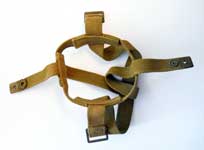 The Pattern taken into service by Canada did not use a sleeve Carrier, as it was not necessary. Though not made clear in Order 500 – it did not need to be – the Carrier was a framework type and was not fitted-up for combination with an Entrenching tool carrier, so had no additional buckle on the base junction of the Carrier straps, as was the case with the Carrier for W.E. Patt. '19 Rifle Equipment. Unlike that for W.E. Patt. ’19 Naval Pistol Equipment, the new Carrier had a top fastened securing strap – the new standard. The change from front-studded to top-studded occurred with the final issue of Carrier for Patt. ’08 W.E., authorised by L. of C. §24092,dated 6th June 1921. It's also worth noting that this design incorporated an elaborate design of attaching the buckled side chapes to the top horizontal strap, as shown in the photo at left, that KW has first noted in the Water bottle carrier for Web Equipment, Officers', Experimental. Compare this with the much simpler method used in the Pattern 1919 examples. Both of these features would be continued in the early skeleton type Carriers used with W.E. Pattern 1937. The example shown was made by M.E.Co. and is conveniently dated 1928. From the Karkee Web Collection.
The Pattern taken into service by Canada did not use a sleeve Carrier, as it was not necessary. Though not made clear in Order 500 – it did not need to be – the Carrier was a framework type and was not fitted-up for combination with an Entrenching tool carrier, so had no additional buckle on the base junction of the Carrier straps, as was the case with the Carrier for W.E. Patt. '19 Rifle Equipment. Unlike that for W.E. Patt. ’19 Naval Pistol Equipment, the new Carrier had a top fastened securing strap – the new standard. The change from front-studded to top-studded occurred with the final issue of Carrier for Patt. ’08 W.E., authorised by L. of C. §24092,dated 6th June 1921. It's also worth noting that this design incorporated an elaborate design of attaching the buckled side chapes to the top horizontal strap, as shown in the photo at left, that KW has first noted in the Water bottle carrier for Web Equipment, Officers', Experimental. Compare this with the much simpler method used in the Pattern 1919 examples. Both of these features would be continued in the early skeleton type Carriers used with W.E. Pattern 1937. The example shown was made by M.E.Co. and is conveniently dated 1928. From the Karkee Web Collection.
During the Second World War, Canada was eventually obliged to manufacture its own webbing. They did not choose to standardise on the “bucket type” Carrier, as did the U.K. Accordingly, they streamlined their production to one form, in both drab and blue-grey. They chose the Naval Pattern 1919 type – with a front stud!!
